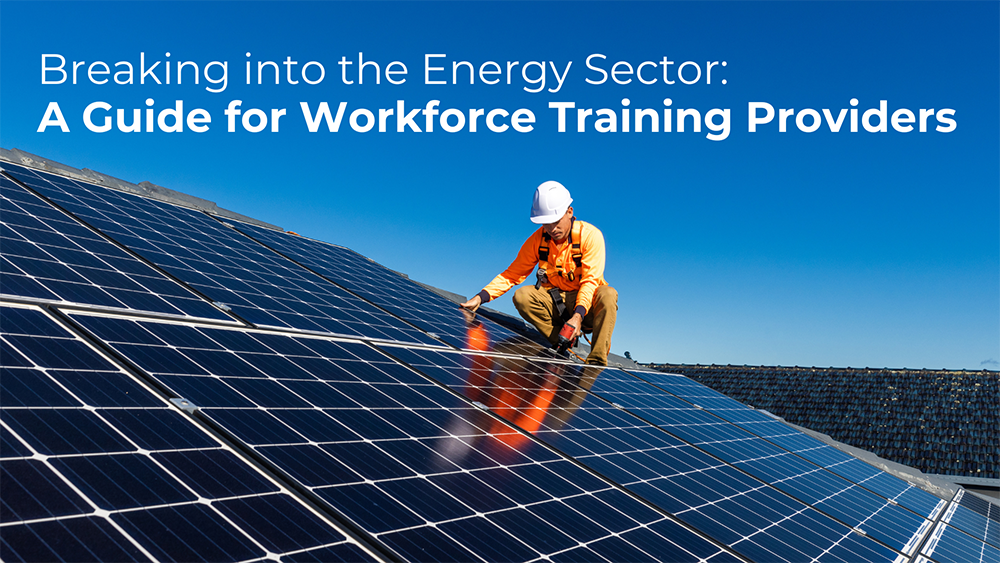Breaking into the Energy Sector: A Guide for Workforce Training Providers

Businesses in the energy sector are some of the country’s most in-demand employers. As the industry transforms to meet the nation’s clean energy goals, long-term financial investment, technology innovation, and growing infrastructure needs make the field uniquely poised to employ the skilled workers of the future. According to the Boston Consulting Group, estimates suggest a global climate and energy workforce shortage of 7 million skilled workers by 2030.
To meet demand and to close the green skills gap, workforce development and job training partners, government agencies, and employers are working together to build a strong talent pipeline.The sector faces unique challenges and offers high-paid career opportunities.Training partners who want to help need to think strategically, build strong industry partnerships, and strengthen their own knowledge about the field before joining in.
Here are three strategies to help workforce development organizations attract more students and position their training program as a key industry partner:
1. Network Like a Pro: Attend Industry Conferences and Events
As the clean energy industry responds to growing demand, partners across the country are coming together to plan for the future. One of the best ways to connect with these industry partners is to meet them in person at conferences and events. This provides a unique opportunity to gain valuable insight into who the key players are, emerging trends, and regional workforce development needs.It’s also Attending events also helps attendees to understand how funding opportunities and regulatory requirements impact the sector’s workforce strategy.
In-person networking events, as well as conference advertising and brand marketing opportunities, give training providers a new platform to position their organization as an engaged industry partner and attract more students.
Clean energy industry conferences include:
- American Clean Power Association Conference
- Advanced Energy Conference
- Center for Energy Workforce Development Summit
- Clean Energy Workforce Education Conference
- CLEANPOWER
- RE+
2. Learn the Lingo: Unlock the Unique Language of the Energy Sector
Every industry has its own terminology, and the U.S. clean energy sector is no exception. Before reaching out to prospective employer partners, leaders should brush up on industry terms, acronyms, concepts, and trends to ensure they can communicate effectively and showcase some industry expertise. Understanding the industry’s unique workforce characteristics, challenges, and needs will also help position an organization as a true industry partner.
An investment in industry-specific staff training prepares team members to engage with new partners in the sector. Attending industry events, exploring online sources, and joining industry organizations are additional ways to “learn the lingo.” When training partners speak the language of the industry they support – their marketing, partnership, and outreach communications are more credible, engaging, and effective.
3. Collaborate With Intention: Build Strong Industry Partnerships
To meet the workforce needs of a growing sector, clean energy industry partners must work together. Luckily, workforce development players understand the importance of collaboration to train skilled workers. To join the clean energy ecosystem, these training partners must build strong partnerships with key industry players, including employers, trade associations, education and research institutions, funding organizations, and government agencies.
Building successful workforce development programs requires training providers to work with employers and other partners to understand and meet the unique needs of the industry, including creating training pathways for job seekers to enter the sector and build meaningful careers.
To build strong industry partnerships:
- Engage with major employers to identify workforce development challenges and opportunities, attract more students, and tailor training programs to meet their needs.
- Partner with trade associations to update current training programs and co-develop new opportunities, including credentialing programs, that open the sector to more talented individuals.
- Leverage grants and funding opportunities from government programs (local, state, and federal), as well as foundations with workforce initiatives.
- Connect to local nonprofits, workforce boards, and economic development organizations to align workforce strategies with regional energy sector growth.
Joining the workforce development ecosystem within the clean energy sector requires a strategic and proactive approach. Attending industry events and collaborating with key stakeholders will help set your training organization up for success. To establish your team as a key player in building a strong pipeline of talent to meet the needs of the industry – focus on funding and partnership opportunities, tailoring training programs to meet the needs of employers, and aligning with long-term industry efforts. With this in mind, your training program can attract more students and help job seekers gain the skills they need to secure rewarding career opportunities in this in-demand industry.
